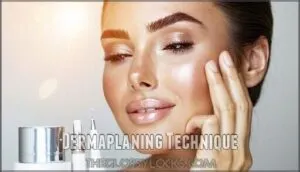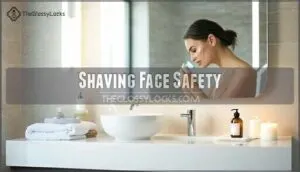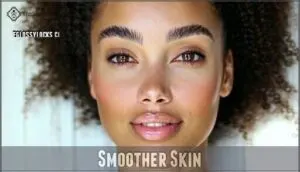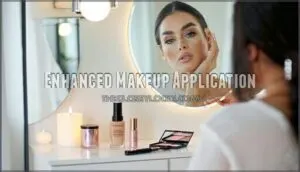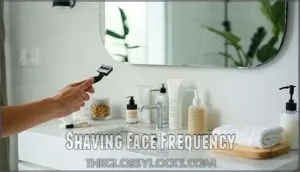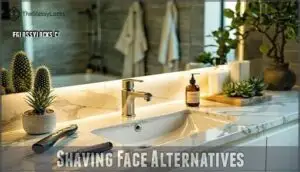This site is supported by our readers. We may earn a commission, at no cost to you, if you purchase through links.
 Shaving your face at home requires the right technique and tools for safe, effective results.
Shaving your face at home requires the right technique and tools for safe, effective results.
Start with clean, dry skin and use a sharp dermaplaning tool or facial razor specifically designed for women. Hold the blade at a 45-degree angle and make short, gentle strokes in the direction of hair growth.
Don’t press too hard—let the razor do the work. Always moisturize afterward to prevent irritation.
While it sounds scary, facial shaving removes dead skin cells and peach fuzz, revealing smoother skin underneath. The key is using proper technique and quality tools to avoid nicks or razor burn that can ruin your skin’s party.
Table Of Contents
- Key Takeaways
- Shaving Face Basics
- Dermaplaning at Home
- Shaving Face Safety
- Shaving Face Benefits
- Shaving Face Frequency
- Shaving Face Alternatives
- Frequently Asked Questions (FAQs)
- Do dermatologists recommend face shaving?
- Is it safe to shave your face at home?
- Is it better to shave your face wet or dry?
- Is it okay to shave the fuzz on your face?
- Can I shave my face during pregnancy?
- What products should I avoid after shaving?
- How do I treat razor burn afterward?
- Can I shave over active breakouts?
- Whats the best razor angle for beginners?
- Conclusion
Key Takeaways
- Master the 45-degree angle technique – Hold your dermaplaning tool at this angle and use short, gentle strokes following the hair growth direction to avoid nicks and irritation.
- Prep your skin properly – Start with completely clean, dry skin and avoid using moisturizers, retinoids, or acids for several days before dermaplaning to prevent complications.
- Don’t overdo the frequency – Dermaplane every 2-3 days for most people, or weekly for sensitive skin, allowing proper recovery time between sessions to maintain your skin’s protective barrier.
- Follow up with proper aftercare – Apply moisturizer immediately after dermaplaning and avoid active ingredients like retinoids or acids for 2-3 days to prevent irritation and razor burn.
Shaving Face Basics
You can safely shave your face at home to remove peach fuzz and dead skin cells, creating smoother skin that’s ready for makeup and skincare products.
This DIY approach to dermaplaning requires the right tools and technique to avoid irritation while achieving professional-looking results.
What is Dermaplaning
At its core, dermaplaning uses a specialized dermatome tool to gently scrape away dead skin cells and vellus hair from your face’s surface.
This skincare routine technique combines facial shaving with skin exfoliation, removing the top layer of dulling debris.
Unlike regular shaving, dermaplaning targets both facial hair removal and cellular renewal, making it a dual-purpose treatment that leaves your complexion noticeably smoother and more radiant.
Dermaplaning also involves using proper dermaplaning tools to achieve the best results.
Benefits of Dermaplaning
Dermaplaning transforms your skincare routine by delivering multiple benefits in one simple treatment.
This gentle technique removes dead skin cells while eliminating peach fuzz, creating a canvas that’s primed for better product absorption and flawless makeup application.
The rewards of facial shaving extend far beyond hair removal:
- Instant glow enhancement – your skin reflects light better without the dulling layer of dead cells
- Smoother texture – goodbye to rough patches and bumps that catch foundation
- Deeper product penetration – serums and moisturizers absorb like they’re meant to
- Confidence boost – that baby-soft feeling you’ll want to touch all day
These dermatological benefits make dermaplaning a game-changer for your skincare goals.
Dermaplaning Tools
Unlike traditional razors with multiple blades, dermaplaning tools feature a single, sharp blade specifically designed for facial exfoliation.
Professional dermaplaning razors have ergonomic handles that provide better control than standard razors. At-home dermaplaning devices include facial scrapers and specialized skincare tools with safety guards.
Choose quality exfoliating tools to guarantee safe, effective results for your DIY dermaplaning routine.
When selecting the right tool, consider investing in high-quality dermaplaning tools to achieve superior skincare results, and remember to prioritize safe and effective methods.
Dermaplaning at Home
You can safely dermaplane at home with the right tools and technique, though it requires more precision than regular shaving.
Start by preparing your skin properly, then follow a systematic approach to avoid common mistakes that could lead to cuts or irritation, using complete concepts and a systematic approach.
Preparing Skin for Dermaplaning
Your skin needs proper preparation before dermaplaning at home.
Start with double cleansing to remove makeup, oil, and dirt completely.
Skip moisturizers and serums that day – your skin must be totally dry for effective exfoliation.
Stop using retinoids, acids, and harsh exfoliants five days prior.
Hydrate well by drinking water beforehand to plump your skin naturally.
For ideal results, consider learning about dermaplaning techniques to enhance your skincare routine.
Dermaplaning Technique
Perfect positioning requires facial mapping for effective vellus hair removal.
Hold your dermaplaning tools at a 45-degree angle, using short downward strokes that follow hair growth patterns. Keep skin taut while moving the blade in feathery motions across your face.
This at-home facial shaving technique combines proper blade angles with systematic exfoliation methods for ideal results.
To achieve the best outcome, understanding dermaplaning techniques is essential for safe and effective facial exfoliation with the right dermaplaning tools.
Safety Precautions
Before handling your blade, understand that razor safety starts with proper preparation.
Always use a fresh, clean blade to prevent infection control issues and minimize exfoliation risks.
Work on dry skin with gentle pressure to avoid razor bumps and skin irritation.
Follow aftercare tips immediately post-treatment, applying moisturizer and SPF for superior skin protection and healing.
To guarantee a safe shaving experience, it’s vital to follow established razor blade safety guidelines to prevent accidents and injuries.
Shaving Face Safety
While dermaplaning at home can transform your skin, understanding proper safety measures prevents common mishaps that could leave you with irritation or nicks.
You’ll want to know the potential risks and how to minimize them before you start your DIY facial hair removal routine.
Common Mistakes to Avoid
While learning proper at-home dermaplaning technique sets you up for success, avoiding common pitfalls guarantees you won’t damage your skin.
These mistakes can turn your shaving face at home routine into a nightmare of razor bumps and irritation.
Here are five critical errors to sidestep:
- Incorrect Technique – Using upward strokes or wrong angles creates razor burn
- Over Exfoliation – Daily dermaplaning strips your skin’s protective barrier
- Poor Sanitation – Dirty blades invite bacteria and infections
- Insufficient Prep – Skipping cleansing leads to clogged pores
- Post Care Errors – Applying harsh products immediately after causes ingrown hairs
Understanding proper safe shaving techniques is essential to avoid these common mistakes.
Potential Side Effects
While generally safe, facial shaving can trigger skin irritation and redness in up to 80% of people.
You might experience razor burn, ingrown hairs, or razor bumps, especially with dull blades or excessive pressure.
Sensitive skin types face higher risks of itching, stinging, and folliculitis.
Post-shave care becomes essential for preventing these common complications, particularly to address issues like razor burn.
Minimizing Risks
Smart skin protection starts with understanding your risk factors before picking up that razor.
You can dramatically reduce complications by following proper safety measures and focusing on injury prevention through careful technique.
- Use fresh, clean blades – Dull razors increase razor burn and skin infections
- Apply gentle pressure – Heavy-handed technique causes razor bumps and ingrown hairs
- Follow proper aftercare tips – Moisturize immediately and avoid active ingredients for 2-3 days
- Maintain shaving safety protocols – Work on clean, dry skin and avoid sensitive areas
Shaving Face Benefits
You’ll notice real benefits from shaving your face at home that go beyond just removing unwanted hair.
The process acts like a gentle exfoliation treatment, giving you smoother skin while helping your skincare products work better and creating the perfect base for flawless makeup application.
Smoother Skin
Facial shaving transforms your skin’s texture through gentle exfoliation tips that remove dead cells and peach fuzz simultaneously.
This dual-action process reveals the fresh layer beneath, creating an instant smooth complexion that feels like silk.
Your skin’s natural facial radiance emerges as bumps and rough patches disappear, and the glow enhancement you’ll notice comes from light reflecting off your newly polished surface.
The shaving technique is a powerful addition to any skin care routine, making your skin feel like silk.
Improved Product Absorption
When you remove facial hair and dead skin cells through shaving, you’re basically clearing the highway for your skincare products.
This enhanced skin penetration allows serums and moisturizers to penetrate deeper into your epidermis, boosting product efficacy dramatically.
Your absorption rates increase, meaning those expensive serums actually deliver their promised benefits.
Better moisture retention keeps your skin hydrated longer, maximizing serum benefits from every drop you apply.
Enhanced Makeup Application
By creating a Smooth Canvas through facial shaving, you’ll achieve a Flawless Finish that makes makeup application effortless.
This exfoliating treatment transforms your Skin Texture, giving cosmetics something to grip onto rather than sliding over peach fuzz and dead skin cells.
- Foundation glides on seamlessly without catching on fine hairs or rough patches
- Makeup Longevity increases dramatically when products can properly adhere to smooth skin
- Blush and bronzer blend evenly across your face without patchy or streaky results
- Concealer coverage improves as it won’t separate or pill over uneven texture
- Cosmetic Enhancement becomes more professional-looking with this simple skin care step
To maximize the benefits of facial shaving, understanding the face shaving guide is essential for achieving ideal results.
Shaving Face Frequency
Getting the timing right prevents over-exfoliation while keeping your skin smooth and glowing. You’ll want to space out your sessions to let your facial skin recover between treatments.
How Often to Shave
Your facial shaving frequency depends on your hair growth cycle and skin sensitivity.
Most people find success shaving every 2-3 days, though some prefer weekly sessions. Monitor how your skin responds to find your ideal shave intervals.
Understanding the ideal shaving face frequency is vital for achieving smooth skin.
| Hair Type | Recommended Frequency |
|---|---|
| Fine/Light | Once weekly |
| Medium Growth | Every 3-4 days |
| Coarse/Fast | Every 2-3 days |
| Sensitive Skin | Weekly or bi-weekly |
Allowing Skin to Recover
Your skin needs breathing room between dermaplaning sessions to complete its natural healing process.
Looking at the paragraph and the tone of the content, here’s a short, engaging blockquote:
**Give your skin the recovery time it deserves between dermaplaning sessions.
This recovery time allows proper skin renewal and prevents over-exfoliation damage. Wait at least a week between treatments, letting your skin rebuild its protective barrier.
During this period, focus on gentle skin care with hydrating serums and moisturizers.
Proper skin hydration supports the healing process, while sun protection shields freshly exfoliated skin from UV damage.
Maintaining Results
Most people need consistency in their facial shaving routine to maintain smooth, radiant results.
Build your skin regimen around weekly dermaplaning sessions, following proper exfoliation tips each time.
Your aftercare routine should include gentle moisturizing and sun protection.
Between sessions, stick to basic facial care with hydrating serums, keeping your skin care routine steps simple while maximizing the benefits of your shaving routine with a steady approach.
Shaving Face Alternatives
While at-home dermaplaning offers excellent results, it’s not your only option for smooth, hair-free skin.
Let’s explore how dermaplaning compares to traditional shaving and other hair removal methods, so you can choose the best approach for your skin type and lifestyle.
Comparing Dermaplaning to Shaving
Think of it like choosing between a butter knife and a chef’s knife for your kitchen needs.
Professional dermaplaning uses surgical precision with specialized facial tools, removing dead skin cells and vellus hair simultaneously for deeper exfoliation methods.
At-home facial shaving with razor blades targets only hair removal, offering convenience without extensive skin renewal.
Both maintain identical regrowth patterns across all skin types, debunking thickness myths completely, and this process is related to skin types.
Other Hair Removal Methods
Beyond shaving, you’ve got several alternatives worth considering.
Tweezing targets individual hairs and lasts up to six weeks, while threading uses cotton thread for precise eyebrow shaping.
Waxing removes hair for several weeks, and sugaring offers gentler pulling action.
Epilation grabs multiple hairs simultaneously, providing four-week results.
Depilatory creams dissolve hair chemically, lasting longer than shaving alone, and are an alternative to other hair removal methods like epilation.
Choosing The Best Option
When selecting the perfect facial hair removal method, you’ll want to match your approach to your specific needs and skin type.
Here’s what to keep in mind:
- Skin sensitivity: Choose dermaplaning for gentle exfoliation or traditional shaving for quick results
- Hair texture: Fine peach fuzz responds well to facial shaving, while coarse hair may need professional techniques
- Budget and convenience: At home facial shaving offers affordability, while salon treatments provide expertise
- Long-term goals: Consider whether you want temporary removal techniques or semi-permanent solutions
Your ideal removal technique depends on balancing effectiveness, safety, and personal preferences for your unique facial tools needs.
Frequently Asked Questions (FAQs)
Do dermatologists recommend face shaving?
Did you know 60% of dermatologists say face shaving is safe for most?
If you steer clear of active acne or eczema, you’re good to go.
Just use a clean blade, gentle strokes, and don’t rush—no need for a close shave!
Is it safe to shave your face at home?
Yes, it’s safe to shave your face at home when done properly.
Use a clean, sharp razor and gentle technique.
Pull skin taut, use light strokes, and avoid sensitive areas like eyelids, using a sharp razor is crucial for safety.
Is it better to shave your face wet or dry?
Like a precision instrument requiring steady hands, dry shaving gives you better control and visibility for face dermaplaning.
You’ll see exactly where you’re working and avoid nicks more easily than with wet shaving, which is a key advantage of dry shaving.
Is it okay to shave the fuzz on your face?
Shaving facial fuzz is completely safe and based on personal preference.
You won’t experience thicker regrowth—that’s a myth.
The blunt feeling comes from cutting hair above skin level, not permanent changes affecting growth patterns.
Can I shave my face during pregnancy?
Picture smooth, radiant skin beneath your growing belly—pregnancy doesn’t pause your skincare routine.
Yes, you can safely shave your face during pregnancy.
It’s gentle, non-invasive, and won’t affect your baby or hormones.
What products should I avoid after shaving?
After face shaving, avoid active ingredients like retinoids, AHA/BHA acids, benzoyl peroxide, and exfoliating scrubs for 2-3 days.
Skip harsh toners and fragranced products.
Your freshly exfoliated skin needs gentle care to prevent irritation and redness.
How do I treat razor burn afterward?
Apply a cool, damp compress for 10-15 minutes to reduce inflammation. Use fragrance-free aloe vera gel or a gentle moisturizer. Avoid touching the area and skip makeup until healed.
Can I shave over active breakouts?
It’s best to avoid shaving directly over active breakouts. You’ll risk irritating inflamed skin, potentially spreading bacteria, and worsening the condition. Instead, carefully work around pimples using gentle strokes.
Whats the best razor angle for beginners?
Hold your razor at a 45-degree angle to your skin. This creates ideal contact for safe hair removal without being too aggressive.
Start gentle—you can always increase pressure slightly as you get comfortable with the technique.
Conclusion
Forget everything you learned about shaving your face at home being scary—it’s actually simpler than assembling IKEA furniture.
With proper technique and quality tools, you’ll achieve smooth, glowing skin without the drama.
Remember to prep your skin, use gentle strokes at 45-degree angles, and moisturize afterward.
Shaving your face at home becomes second nature with practice, giving you salon-quality results from your bathroom.
- https://my.clevelandclinic.org/staff/7887-melissa-piliang
- https://www.mdcsnyc.com/provider/brendan-camp-md
- https://www.mayoclinic.org/diseases-conditions/pcos/symptoms-causes/syc-20353439
- https://www.google.com/search?q=facial+hair+grwoth+women&rlz=1C5CHFA_enUS988US988&oq=facial+hair+grwoth+women&aqs=chrome..69i57j0i13l9.2261j0j4&sourceid=chrome&ie=UTF-8
- https://www.instagram.com/dresteewilliams/


